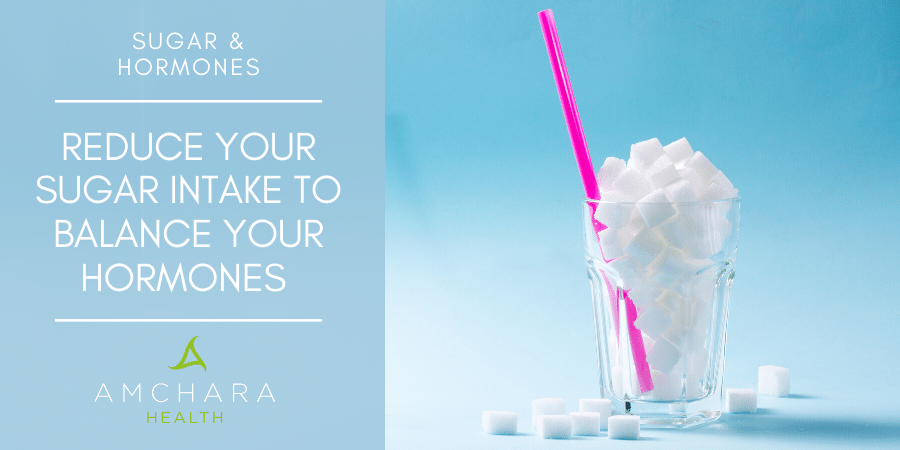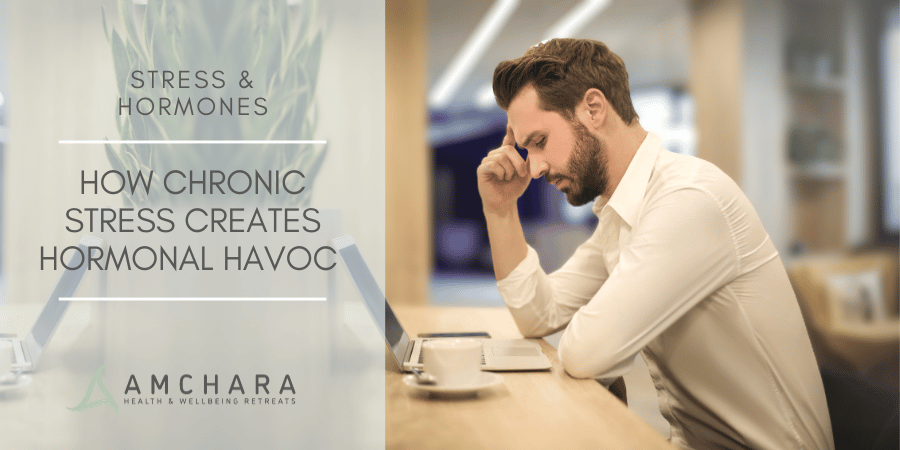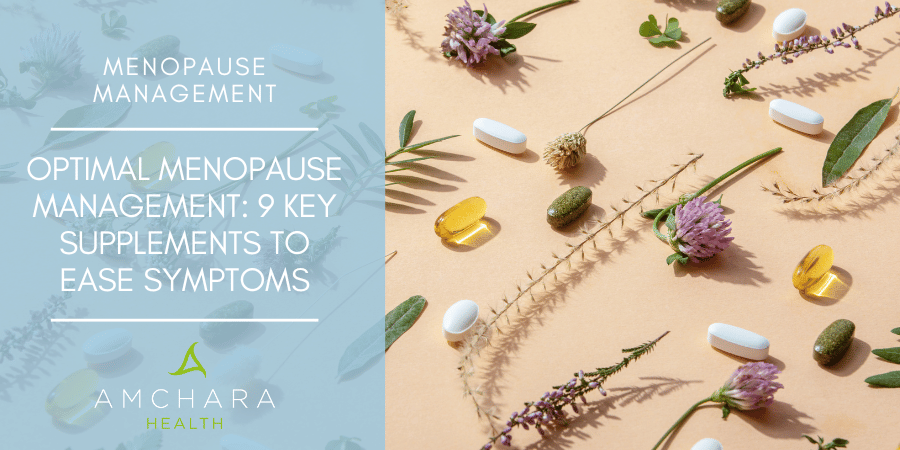Do you have a sweet tooth? Do you turn to sugar when you’re stressed or down, or rely on a sweet treat when your energy is flagging? If so, then maybe this New Year it’s time to examine your relationship with sugar.
The connection between sugar and weight gain is well known, and it is now understood that eating excess sugar can increase your risk of developing metabolic diseases like cardiovascular disease, obesity and Type 2 diabetes. But did you know sugar can also contribute to hormone imbalance?
We always take an evidence-based approach and aim to provide you with actionable knowledge and tips to help you on your journey to optimal health. In this article we’ll examine sugar addiction, find out about hidden sugar in food, and have a look at how to give your system a chance to rebalance itself by reducing your sugar intake.
What is sugar?
In its most simple form, sugar is a monosaccharide, a single molecule known as glucose. Sugar can also be found as fructose, another monosaccharide. Sucrose or table sugar is a disaccharide, composed of one molecule of glucose and one of fructose.
Sugar is found naturally in fruits and vegetables and it is typically added in some form to almost all processed foods and drinks, to give them a sweeter flavour.
It can be a little confusing to recognise added sugar because on food labels it can appear under many different names. Dextrose, lactose, high fructose corn syrup, brown rice syrup and agave nectar are all used to add sweetness. In fact over 60 different names for sugar are in existence.
Sugar in processed food
You may not have realised added sugar is so widespread in processed foods, and its presence in savoury foods may be particularly surprising.
Sugar is added to yoghurt, especially low fat varieties, condiments, sauces, breakfast cereals, cooked meats, savoury ready meals, salad dressings, tomato sauce, tinned foods and commercially produced peanut butter.
Food manufacturers add sugar because they want to persuade us to buy their food. Processed food is now engineered to have a ‘bliss point’, or maximum taste satisfaction, using the perfect ratio of fat, salt and sugar, designed to encourage you to eat the food and crave more of it.
The addition of sugar also extends the shelf life of the food.
Why do we love sugar?
Historically, humans are attracted to sweet tasting foods. In nature, sweet foods are typically not poisonous, so for our early ancestors a preference for sweetness was a way to avoid eating toxic plants.
The human body is designed to use carbohydrates as fuel. These are broken down in the course of digestion to glucose, which is then released into the bloodstream to provide energy to cells. The energy required to fuel the brain is largely dependent on glucose, and it’s a very energy-hungry organ, using around 20% of your daily energy intake, despite weighing only 2% of your total body weight.
So our built-in preference for sugar may also be a mechanism to ensure we satisfy the brain’s need for readily available fuel.
Sugar helps the body to lay down surplus energy as fat; in hunter-gatherer times this would have allowed a better chance of survival during winter, when food was more scarce.
Nowadays we live in an era of non-stop food availability, much of it loaded with refined carbohydrates and simple sugars. According to surveys, on average only around one third of all food purchased in Europe is unprocessed. Half of all the food bought in the UK is now ‘ultra-processed’ (1). Ultra-processed refers to food with added ingredients such as preservatives, colourings and sweeteners which wouldn’t usually be found in homemade, whole food. The most commonly eaten ultra-processed foods eaten in the UK include industrially produced bread, ready meals, breakfast cereals and sausages.
The average adult in the UK now consumes almost 60g refined sugar per day, while for 11-18 year olds the figure is almost 70g per day – equivalent to over 17 teaspoons. This includes all sugars added by food manufacturers as well as fruit juice, syrups and honey. Cereal, sweetened beverages and confectionary make up the bulk of this sugar.
The UK government recommendations are that no more than 5% of your total energy intake should come from refined sugars, however for the average person sugar provides around 13% of their total energy intake (2).
This massive increase in added sugar is connected to a multitude of health problems. In the past, excess fat in food was seen as a major contributing factor in the development of many lifestyle illness such as Type 2 diabetes and obesity, but it’s now clear sugar and refined carbohydrates pose more of a problem.
Sugar addiction
Scientists have noted sugar consumption causes symptoms similar to those experienced with addictions.
When you eat food containing sugar, taste buds which detect sweet foods are activated on your tongue. They send signals to the brainstem, setting off a cascade of chemical reactions. A substance called dopamine is released – associated with pleasure and reward, as well as the recall of pleasurable experiences. So your brain decides the activity is something you should repeat (3).
The same happens if you engage in other enjoyable pastimes, causing you to carry on with the pleasurable activity.
Excessive activation of the reward centres in the brain however can lead to the brain’s dopamine receptors becoming desensitised. This means more and more dopamine is needed to experience those pleasant feelings. You can experience cravings, as well as negative feelings and behaviour, if those cravings are not satisfied.
An increased tolerance to the pleasurable stimulus – in this case sugar – is the result, making it harder and harder to satisfy the cravings. This is how addictions develop, for example to cigarettes, alcohol, recreational drugs or sugar.
Some researchers suggest refined sugar stimulates the pleasure centre in the brain to a greater degree even than cocaine. Laboratory rats addicted to cocaine will switch to sugar if it’s introduced into their environment.
However, it is important to remember sugar addiction is only a risk when excess refined sugar is eaten. We’ve evolved to consume natural sugars bound up with fibre and complex carbohydrates in whole plant foods, because we need them to obtain energy.
The sugar rollercoaster
As we’ve seen, the energy your body’s cells need to carry out their functions is provided by glucose, obtained from food.
Different foods are broken down by the body to release their stored glucose into the bloodstream at different rates. If a food is high in simple sugars or contains little fibre, the glucose is absorbed rapidly, resulting in blood sugar levels rising quickly. Disaccharides are broken down more rapidly into glucose than carbohydrates, while glucose and fructose are absorbed directly into the bloodstream.
To bring down this elevated blood sugar your pancreas will secrete insulin, the hormone telling cells to let glucose to be used as an energy source.
The problem is if the pancreas constantly releases insulin, due to fluctuations in blood glucose from eating sweet foods, it can become overreactive and secrete too much insulin. This will bring blood sugar levels crashing down quickly, leaving you feeling jittery, weak and craving sugar. You feel this way because your brain registers its need for more glucose and tells you to eat something sweet, to provide instant energy. But by reaching for a sweet snack, a cycle of blood sugar highs and lows will begin.
When insulin is high, the body will tend to deposit any surplus energy into fat cells, leading to weight gain. Meanwhile, consistently high insulin can mean the body’s cells become hard of hearing and don’t act on the message of insulin, so blood sugar levels increase. This is called insulin resistance.
When blood sugar levels are constantly fluctuating and the pancreas is pumping out insulin, its function may eventually become compromised and it will start to produce insufficient insulin. The result is blood sugar levels which climb too high and a risk of developing Type 2 diabetes.
Sugar and your hormones
We now know excessive sugar consumption can profoundly affect insulin levels.
A knock on effect of this increase in insulin is disruption in the balance of other hormones. In women, testosterone tends to increase, which may prevent ovulation and cause irregular menstrual cycles, excess body hair or acne. In men, insulin resistance can lead to low testosterone levels.
Unbalanced blood sugar levels are also connected with PMS. Many women can relate to craving sugary foods at certain times in their cycle. This causes spikes and dips in blood glucose levels, triggering the release of the stress hormone cortisol. Blood sugar levels, cortisol and the sex hormones are closely related.
Cortisol is manufactured from the same material used to make progesterone. Because the body will prioritise the manufacture of stress hormones, anything prompting cortisol release, including fluctuating blood sugar levels, may deplete progesterone.
Low levels of progesterone relative to oestrogen may worsen PMS symptoms and excess cortisol is linked to inflammation, potentially increasing the pain and discomfort of menstrual cramps.
Managing your sugar intake
Now we’re aware of the health effects of sugar, particularly added sugar, you may want to reduce your sugar intake. Because of the strong message to eat sugar sent by the brain, simply avoiding it is not as easy as it may sound.
However, because sugar addiction is fed by consuming more of the sweet stuff, avoiding sugar can successfully break your addiction in the long term, by educating your brain not to expect a sugar rush and starting to retrain your sweet tooth. Once your blood sugar starts to become more balanced, you will find you crave sugar less.
Like any addiction, if you’re hooked on sugar you may experience withdrawal effects initially, including symptoms such as headaches, irritability or anxiety. However, these unpleasant side effects will pass.
One easy way of avoiding added sugar is to switch to whole, natural foods. Unprocessed foods contain a balance of unrefined carbohydrates (which have less of an impact on blood sugar levels), fat, protein and plenty of natural fibre to slow sugar release.
To reduce sugar cravings, make sure you’re consuming plenty of protein, such as grass-fed beef, chicken, pulses, oily fish and eggs. It’s helpful to include omega-3 essential fats, found in oily fish, flax seed oil, pumpkin seeds and walnuts, as well as healthy saturated fats in the form of coconut oil.
Homemade soups and casseroles, using a variety of fresh vegetables and pulses, are not only wholesome and delicious, but can also be a timesaver if you make a big batch and freeze portions for use on a later date.
Replace sugary mid-afternoon snacks with a handful of unsalted fresh nuts like almonds or walnuts, or some pumpkin seeds.
Foods which are simply more convenient to use ready-made, such as tomato sauce or nut butters are available in no added sugar varieties from health food stores.
If you can’t face giving up sugar just yet, why not try decreasing your intake slowly? Reduce sugar in hot drinks gradually and dilute fruit juice 50:50 with water. Choose snacks with no added sugar and avoid sugar-rich dates or dried fruits such as raisins, which are high in sugar. Try natural sugar substitutes which taste sweet but have less of an impact on your blood sugar, like stevia or xylitol.
Takeaway
Reducing your sugar intake can be challenging, so if you would like one-to-one support in your journey towards a positive relationship with healthy food, a consultation with an Amchara Personalised Health practitioner can provide you with tips on how to reduce your intake of sugar and explore the power of nutrition to gain optimal health, tailored to your individual circumstances and health goals.
We believe sharing knowledge and experience is an important part of achieving optimal health and would love to hear your views and experiences.
Tell us what you found useful about this article.
Do you have any tips for reducing sugar intake?
Read this next:




